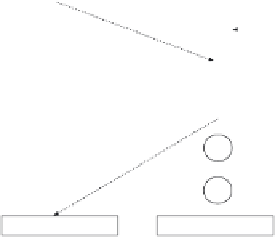Cryptography Reference
In-Depth Information
24
@$
F
G
=
F
G
3
=
F
3
3
=
F
2
2
2
F
2
@$
'
Figure 10.1
The DES encryption algorithm.
of
C
is 32 bits. It is subject to the permutation
P
, as specified in Table 10.5. If
C
=
c
1
c
2
...c
32
,then
P
(
C
)=
c
16
c
7
...c
25
. The result is
f
k
(
R
), and it is the
output of the round function
f
.
The S-boxes
S
1
,...,S
8
of the DES are illustrated in Table 10.6. Each S-
box can be represented by a table that consists of 4 rows and 16 columns. If
B
=
b
1
b
2
b
3
b
4
b
5
b
6
2
represents a
number between 0 and 3 (this number is the row index for the table), whereas the
binary string
b
2
b
3
b
4
b
5
∈{
is input to
S
i
, then the binary string
b
1
b
6
∈{
0
,
1
}
4
represents a number between 0 and 15 (this number
is the column index for the table). The output of
S
i
(
B
) is the number found in the
table (on the row that corresponds to the row index and the column that corresponds
to the column index), written in binary notation. For example, if
B
= 011001,then
the row index is
b
1
b
6
=01=1and the column index is
b
2
b
3
b
4
b
5
= 1100 = 12.
0
,
1
}


























